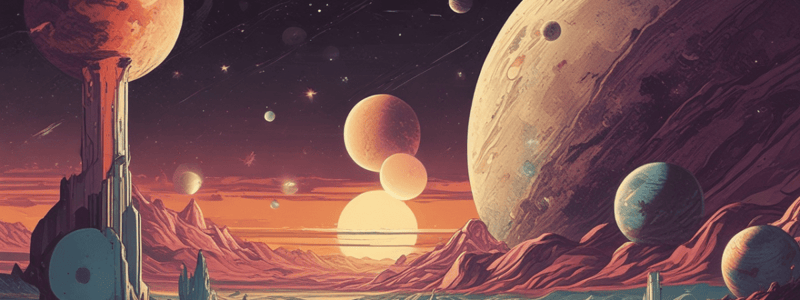Podcast
Questions and Answers
ما هي أحد خصائص الكواكب في نظام TRAPPIST-1؟
ما هي أحد خصائص الكواكب في نظام TRAPPIST-1؟
- الكواكب أصغر من كوكب الأرض بمرة واحدة
- الكواكب أكبر من كوكب الأرض بمرة واحدة
- الكواكب أكبر من كوكب الأرض بأربع مرات
- الكواكب أصغر من كوكب الأرض بثلاثة أرباع (correct)
ما هي الطريقة الرئيسية التي تتشكل بها النظم الشمسية؟
ما هي الطريقة الرئيسية التي تتشكل بها النظم الشمسية؟
- من خلال الانشطار النووي في السحب الكونية
- من خلال الاندماج النووي في السحب الكونية
- من خلال الانهيار الذاتي للسحب الكونية تحت تأثير الجاذبية (correct)
- من خلال الانفجارات الضخمة في السحب الكونية
ما هي الخطوة التالية في تكوين النظام الشمسي بعد تشكل النجم الأولي؟
ما هي الخطوة التالية في تكوين النظام الشمسي بعد تشكل النجم الأولي؟
- تكوين الكواكب حول النجم (correct)
- تكوين الكويكبات والمذنبات حول النجم
- تكوين الأقمار الصناعية حول الكواكب
- تكوين الأقراص الغبارية حول النجم
ما هي الأجسام الأخرى التي تتكون في النظام الشمسي بالإضافة إلى الكواكب؟
ما هي الأجسام الأخرى التي تتكون في النظام الشمسي بالإضافة إلى الكواكب؟
كيف تساعدنا دراسة بنية النظم الشمسية في فهم الكون؟
كيف تساعدنا دراسة بنية النظم الشمسية في فهم الكون؟
ما هو النجم المركزي في نظام TRAPPIST-1؟
ما هو النجم المركزي في نظام TRAPPIST-1؟
ما هي المكونات الرئيسية للنظام الشمسي؟
ما هي المكونات الرئيسية للنظام الشمسي؟
ما هي العوامل التي تؤثر على خصائص النظام الشمسي؟
ما هي العوامل التي تؤثر على خصائص النظام الشمسي؟
ما هي المدى المتوقع لأحجام الكواكب في الأنظمة الشمسية؟
ما هي المدى المتوقع لأحجام الكواكب في الأنظمة الشمسية؟
ما هي الميزة البارزة للنظام الشمسي KOI-961؟
ما هي الميزة البارزة للنظام الشمسي KOI-961؟
ما هي الميزة البارزة لنظام النجمة كيبلر-90؟
ما هي الميزة البارزة لنظام النجمة كيبلر-90؟
ما هي المسافة التقريبية لنظام KOI-961 من الأرض؟
ما هي المسافة التقريبية لنظام KOI-961 من الأرض؟
Flashcards are hidden until you start studying
Study Notes
Solar Systems are vast structures made up of stars, planets, moons, asteroids, comets, and other celestial bodies. These systems orbit around their respective stars, which can vary greatly in size, mass, age, temperature, and composition. In this article, we will explore the concept of solar systems and discuss some notable features found within them.
Planetary Systems and Their Components
Planetary systems consist of central stars surrounded by planets, dwarf planets, moons, and other small objects such as asteroids and comets. Stars like our Sun have significant effects on their planetary systems' characteristics, including the presence of habitable planets where life might exist. A wide range of sizes and masses exist among these stellar companions, with planets typically ranging from less than 0.07 times Earth's radius to more than 2,500 times its mass.
Notable Features of Planetary Systems
Some unique traits make certain planetary systems stand out in the universe. For instance, KOI-961 is an exoplanet system located approximately 1,600 light years away from Earth. It has been identified as having a giant gas planet called KOI-961.01, estimated to be 235 times the mass of Earth. Another example is the Kepler-90 star system, home to eight confirmed planets. This system exhibits diverse planetary compositions, including both hot rocky worlds and potential super-Earths.
Furthermore, the TRAPPIST-1 planetary system contains seven planets orbiting a red dwarf star, which is smaller and cooler than our own Sun. These planets range in size between 0.3 and 1.4 times Earth's diameter, making them suitable candidates for studying the possibility of habitability and the presence of life-supporting environments.
Solar System Formation
Solar systems are formed from interstellar gas and dust clouds that collapse under their own gravity, forming protostars. Over time, these protostars form into main-sequence stars surrounded by disks of debris left over from the formation process. Planets within these systems grow through varying mechanisms, including accretion, where small particles gradually coalesce into larger bodies.
In summary, solar systems consist of central stars surrounded by diverse celestial bodies such as planets, moons, asteroids, comets, and other objects. Understanding these structures helps us comprehend the vastness of our universe and the complex processes involved in planetary evolution and habitability.
Studying That Suits You
Use AI to generate personalized quizzes and flashcards to suit your learning preferences.



